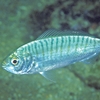General Description
Body long, cylindrical, with united dorsal, caudal and anal fins; dorsal fin arising above or slightly before the anal fin. To 1.1 m.
Biology
Southern Shortfin Eels have a catadromous life-cycle, spending 20 years or more in freshwaters before they migrate to the open sea to breed. They spawn in deepwaters of the Coral Sea, and the transparent eel leptocephalus larvae are pelagic in the open ocean. The larvae metamorphose into glass eels which then migrate into estuaries before transforming into juvenile eels, called elvers.
Habitat
Coastal drainages, in streams, lowland rivers, lakes and swamps, generally with low or no flow as juveniles and adults.
Reefs
Soft substrates
Distribution guide
South-western Pacific. Eastern and south-eastern Australia.
Species Group
Depth
Water Column
Max Size
1.1 m
Commercial Species
Yes
Global Dispersal
Native to Australia
Conservation Status
- DSE Advisory List : Not listed
- EPBC Act 1999 : Not listed
- IUCN Red List : Not listed





